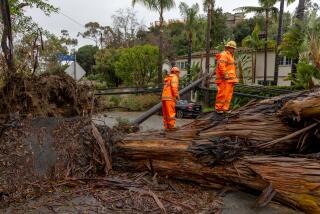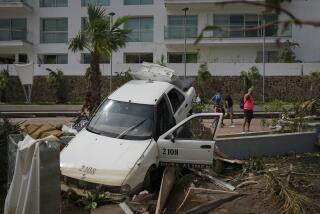Few lights, but many questions
Utility-company crews had restored electricity by Monday to half of the 1.5 million Central Florida residents who lost power in Hurricane Charley, but this success spawned new anxiety and envy among those still left in the dark.
“We’ve been hit heavy, and it seems like nobody’s been out here,” said Jane Sowers, a 41-year-old accountant and customer of Progress Energy Florida in south Seminole County.
Like the nearly 750,000 other people who remain without electricity in the seven-county area, Sowers had only one question: When will my power be on?
Officials for local government and the region’s four main electric utilities could not offer definitive answers, only vague deadlines, such as within a week.
“People are rightly concerned about getting their lives returned to normal,” said Orange County Chairman Rich Crotty. “Every day that passes, the frustration level will increase.”
According to the power companies, 151,709 customers went back on line Monday. More than 411,000 clients remained powerless, but 50 percent of customers had been restored to power since the Friday night storm.
The estimate of people affected by Charley is much higher than the number of power customers, which represent homes and businesses. Most customers are households, which typically hold 2.5 people each.
While no one without electricity could be expected to be happy, the people of Winter Park were especially upset Monday. Several expressed fear their electric provider, Progress Energy, is ignoring them because they voted earlier this year to buy back the system from the publicly traded company.
“There’s no way to prove it. . . . But it’s disconcerting. You wonder,” said Michael Schwartz, owner of Pannullo’s Italian restaurant on Park Avenue, the main drag through Winter Park’s closed-down business district.
Schwartz, whose eatery lost power as Charley whipped through the region Friday night, said he had not seen a Progress Energy truck or crew in four days.
A Progress Energy spokeswoman, Cherie Jacobs, denied Schwartz’s charge, saying, “Oh, my gosh; no, we are not ignoring Winter Park.”
Progress, she said, has 6,000 workers in the field, many of them trying to replace broken lines and substations in remote areas. That work, she said, sets the stage for restoring power to businesses and homes.
“If you live in an individual neighborhood, you are not going to see that,” Jacobs said.
Orange County officials said they were pleased with the cleanup efforts of Progress Energy.
“As time goes by, they’re going to encounter tougher and tougher cases, and it looks like Belle Isle, Conway and Winter Park are going to struggle with that,” County Administrator Ajit Lalchandani said.
Progress Energy has promised to have power to everyone in Orange, Osceola, Seminole and Volusia counties by midnight Saturday.
Parts of Polk County, where five people died during Charley’s onslaught, were among the most heavily damaged areas. Power will not be restored there until Aug. 24, Progress Energy officials said.
Leaders of the Orlando Utilities Commission, which serves Orlando, St. Cloud and parts of south Orange, said “the vast majority” of customers should have power by midnight Friday.
Spokesman Sheridan Becht said OUC was concentrating on such priorities as sewage plants, traffic lights and schools, in addition to neighborhoods.
“It’s going to take a while, and we have to make sure what we do makes sense in the big picture,” Becht said.
OUC, which has as many as 150,000 customers without power, was down to 40,000 darkened clients Monday.
The city-owned utility, Becht said, has about 500 workers repairing lines. That’s up from a usual complement of about 80. The utility, he said, also has nearly 200 tree trimmers on the streets, up from the usual staff of 16 to 20.
“You may hear chain saws during the night. I hope that’s music to customers without power,” said Ken Kisoneck, OUC’s interim general manager.
Doug Guetzloe, Orlando political activist and OUC customer, questioned how the utility was using its workers, saying he had driven around much of the city Monday and saw few workers.
“I can’t find an OUC truck anywhere. What are they doing?” Guetzloe said.
The Florida Public Service Commission requires companies to maintain service standards that don’t leave people without electricity for extended periods. But those rules typically deal with day-to-day problems, not hurricanes.
The PSC regulates publicly owned companies such as Progress Energy and Florida Power & Light, but not the city-owned OUC or Kissimmee Utility Authority.
“Hurricanes are off the charts,” said PSC spokesman Kevin Bloom. “You can’t engineer for that. You can’t build a system to withstand that.”
He said there are no standards governing how many extra workers a company must hire to rebuild. Typically, they borrow from utilities outside the stricken areas.
“There are some economies in that kind of sharing. It may delay some things, but it’s a trade-off. If you want the power up in one hour, expect to pay more the rest of the time,” said Sanford Berg, professor of economics at the Public Utility Research Center at the University of Florida.
Part of the problem in requesting emergency crews for Charley was that no one could say for sure where the storm was headed. Utilities in other parts of Florida couldn’t release their extra workers because they thought they might need them. States closest to Florida faced the same concern.
“I reserved 150 [extra workers],” Kisoneck said. “It’s a guessing game. How much insurance do you pay for? I wish it were more in hindsight. I hoped the storm would skirt us, but we got clobbered.”
To pay for repairs and extra help, Bloom said, companies draw on their storm-reserve fund, which is built into the rates companies charge. FPL has $236 million; Progress, $40.9 million. OUC has $30 million set aside. KUA said it is insured, but could not say for how much.
After hurricanes Andrew in 1992 and Hugo in 1989, it took five to seven days to restore electricity to such critical areas as hospitals and to main transmission lines, which are directly connected to the power plants. Three weeks passed before 95 percent of residences had power again, said Ron Cook, University of Florida professor of civil engineering, who studied the hurricanes’ aftermath.
But residents without power Monday did not care to hear about history.
Ava Cameron, who lives on Howell Branch Road, east of State Road 436, said she has called Progress Energy repeatedly but has gotten no help.
“I’m not getting anywhere with them,” said Cameron, a homemaker in her 60s.
She said her food is spoiled, her house is hot and her pile of dirty clothes keeps growing. “It’s not a happy situation,” she said.
Betsy Moricle, however, had no complaints. Power to her home in Orlando’s College Park neighborhood was restored Saturday afternoon, less than a day after she lost it.
“I feel so lucky,” said the 35-year-old homemaker and mother of two young children.
Her parents, who live in Longwood, have no power, Moricle said. So they come over to shower and visit.
Moricle admitted to feeling guilty about her good fortune, saying she has thought about skipping a shower or two because “you don’t want people mad at you.”
Melissa Harris and Susan Jacobson contributed to this report. Dan Tracy can be reached at 407-420-5444 or dtracy@orlandosentinel.com. Debbie Salamone can be reached at dsalamone@orlandosentinel.com or 407-420-5456.
More to Read
Start your day right
Sign up for Essential California for news, features and recommendations from the L.A. Times and beyond in your inbox six days a week.
You may occasionally receive promotional content from the Los Angeles Times.






